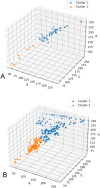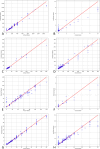Revolutionizing Chinese medicine granule placebo with a machine learning four-color model
- PMID: 40170087
- PMCID: PMC11963323
- DOI: 10.1186/s13020-024-01055-0
Revolutionizing Chinese medicine granule placebo with a machine learning four-color model
Abstract
With the development of new Chinese medicines and the need for clinical double-blind experiments, the use of placebos in Chinese medicine is becoming increasingly important. However, due to the diverse colors and complex color gamut of these particles, existing simulation methods rely on manual comparison and color mixing, leading to high subjectivity and errors. This study addresses this issue by developing a prediction model to accurately simulate the colors of Chinese medicine granules. In this study, 52 commercially available herbal particles were collected. And more than 320 simulated granules were prepared using fillers and four pigments (lemon yellow, carmine, indigo and caramel colors). Their RGB colors were collected using visible light imaging. A granule color prediction model was constructed by machine learning. First, the best clustering model was obtained by optimising the k-value of the Kmeans model. Subsequently, multiple regression models, including Gradient Boosting Regression (GBR), Support Vector Regression (SVR), and Random Forest, were evaluated through network search and cross-validation methods. Among these models, the average R2 of the random forest model reached 0.9249, outperforming other models. The prediction model accurately simulated the color of Chinese medicine granules, with an average color difference (ΔE) of 2.7734 and a high RGB value cosine similarity of 0.9999, alongside a 0.9366 similarity in artificial color scoring. This study introduces an innovative approach for the rapid and accurate prediction of granule colors, facilitating the development of clinically applicable placebos in traditional Chinese medicine.
Keywords: Color prediction; Color similarity; Machine learning; Placebo; Traditional Chinese medicines.
© 2025. The Author(s).
Conflict of interest statement
Declarations. Ethics approval and consent to participate: Not applicable. Competing interests: The authors declare that they have no known competing financial interests or personal relationships that could have appeared to influence the work reported in this paper. Consent for publication: All authors agree to the publishing of this article in Chinese Medicine.
Figures










References
-
- Teoh ES. Traditional Chinese medicine, Korean traditional herbal medicine, and Japanese Kanpo medicine. In: Teoh ES, editor. Medicinal orchids of Asia. Cham: Springer International Publishing; 2016. p. 19–31. 10.1007/978-3-319-24274-3_2.
-
- Enck P, Klosterhalfen S. Placebos and the placebo effect in drug trials. Handb Exp Pharmacol. 2019;260:399–431. - PubMed
Grants and funding
LinkOut - more resources
Full Text Sources

